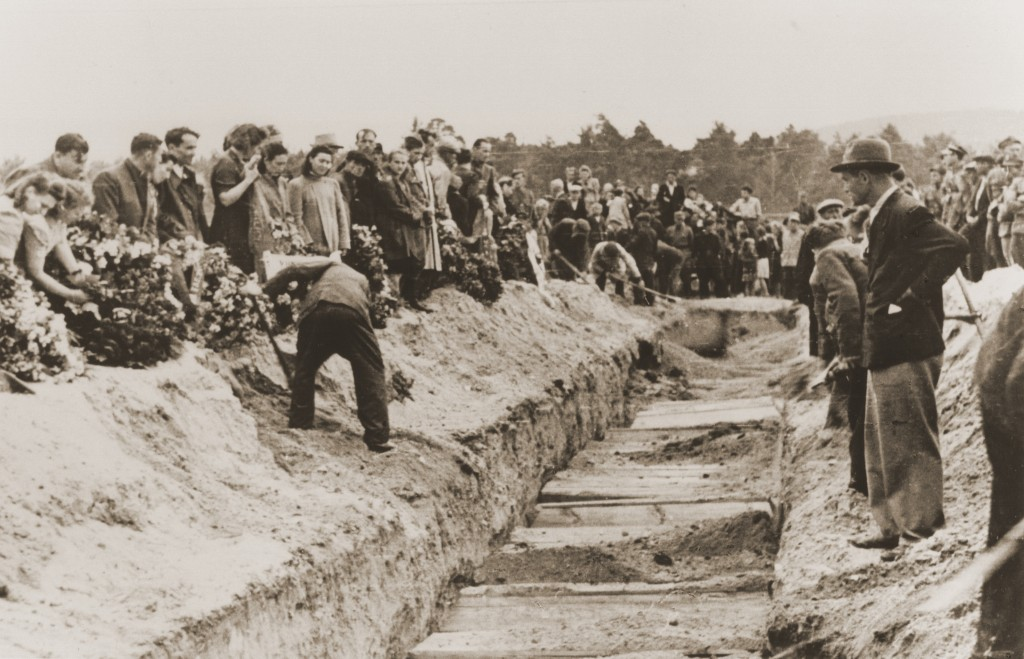
Kielce Jews Massacred in "Blood Libel" Pogrom
On July 4, 1946, civilians, soldiers, and police killed 42 Polish Jews and injured 40 others in the southeastern town of Kielce.
View newspaper articlesThe term Kielce pogrom refers to a violent massacre of Jews in the southeastern Polish town of Kielce on July 4, 1946. Pogrom is a Russian word meaning “to wreak havoc, to demolish violently.” Historically, the term refers to violent attacks by local non-Jewish populations on Jews in the Russian Empire.
In March 1942, Nazi officials established a ghetto in Kielce with 25,000 inhabitants. Almost all of these individuals were murdered during the Holocaust. By the summer of 1946, about 200 Holocaust survivors had returned to or settled in Kielce. A minority were able to reclaim some property that had been confiscated by non-Jews during the German occupation.
On July 1, 1946, a nine-year-old non-Jewish boy, Henryk Blaszczyk, left his home in Kielce, without informing his parents. When he returned on July 3, the boy told his parents and the police, in an effort to avoid punishment for wandering off, that he had been kidnapped and hidden in the basement of the local Jewish Committee building. The Committee building sheltered up to 180 Jews, and housed various Jewish institutions operating in Kielce at the time. On the next day, the local police went to investigate the alleged crime in the building. Although by now Henryk's story had begun to unravel (the building, for example, had no basement), a large crowd of angry Poles, including one thousand workers from the Ludwikow steel mill, gathered outside the building.
Polish soldiers and policemen entered the building and called upon the Jewish residents to surrender any weapons. After an unidentified individual fired a shot, officials and civilians fired upon the Jews inside the building, killing some of them. Outside, the angry crowd viciously beat Jews fleeing the shooting. By day's end, civilians, soldiers, and police had killed 42 Jews and injured 40 others. Two non-Jewish Poles died as well, killed either by Jewish residents inside the building or by fellow non-Jewish Poles for offering aid to the Jewish victims.
Three days after the pogrom, surviving Jews and local residents buried the victims in a mass grave in the Jewish cemetery. Government authorities ordered military units and local residents to attend the funeral as a sign of respect for the victims. Although the government executed nine of the attackers on July 14, following a hasty judicial investigation, the Kielce Pogrom sparked intense fear in the already traumatized postwar Polish Jewish community.
The Kielce pogrom was not an isolated instance of anti-Jewish violence in postwar Poland, and it convinced many Polish Jews that they had no future in Poland after the Holocaust and spurred them to flee the country.
Learn More about this Historical Event
The Kielce Pogrom: A Blood Libel Massacre of Holocaust Survivors (Encyclopedia Article)
Bibliography
Brass, Paul R., editor. Riots and Pogroms. New York: New York University Press, 1996.
Engel, David, "Patterns of Anti-Jewish Violence in Poland, 1944-1946," Yad Vashem Studies Vol. XXVI, Jerusalem 1998, pp 43-85.
Gross, Jan T. Fear: Anti-Semitism in Poland After Auschwitz: An Essay in Historical Interpretation. New York: Random House, 2006.
Kielce, July 4, 1946: Background, Context and Events. Chicago: The Polish Educational Foundation in North America, 1996.
Klier, John D., and Shlomo Lambroza, editors. Pogroms: Anti-Jewish Violence in Modern Russian History. Cambridge: Cambridge University Press, 1992.
Meducki, Stanislaw. "The Pogrom in Kielce on 4 July 1946." Polin: Studies in Polish Jewry 9 (1996): 158-169.
Search tips
These dates and keywords are associated with this historical event.